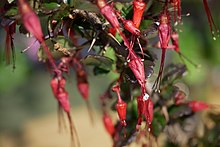en
names in breadcrumbs


Ribes (/ˈraɪbiːz/)[5] is a genus of about 200 known species of flowering plants, most of them native to the temperate regions of the Northern Hemisphere.[2] The various species are known as currants or gooseberries, and some are cultivated for their edible fruit or as ornamental plants. Ribes is the only genus in the family Grossulariaceae.
Ribes species are medium shrublike plants[6] with marked diversity in strikingly diverse flowers and fruit.[7] They have either palmately lobed or compound leaves, and some have thorns.[6] The sepals of the flowers are larger than the petals, and fuse into a tube or saucer shape.[6] The ovary is inferior, maturing into a berry with many seeds.[6]
Ribes is the single genus in the Saxifragales family Grossulariaceae. Although once included in the broader circumscription of Saxifragaceae sensu lato, it is now positioned as a sister group to Saxifragaceae sensu stricto.[8]
First treated on a worldwide basis in 1907,[9] the infrageneric classification has undergone many revisions,[10] and even in the era of molecular phylogenetics there has been contradictory evidence.[7] Although sometimes treated as two separate genera, Ribes and Grossularia (Berger 1924),[11] the consensus has been to consider it as a single genus, divided into a number of subgenera, the main ones of which are subgenus Ribes (currants) and subgenus Grossularia (gooseberries), further subdivided into sections.[10] Janczewski (1907) considered six subgenera and eleven sections.[9] Berger's twelve subgenera based on two distinct genera (see Senters & Soltis (2003) Table 1) have subsequently been demoted to sections.[8][7] Weigend (2007) elevated a number of sections to produce a taxonomy of seven subgenera; Ribes (sections Ribes, Heretiera, Berisia) Coreosma, Calobotrya (sections Calobotrya, Cerophyllum), Symphocalyx, Grossularioides, Grossularia, Parilla.[12][13]
Taxonomy, according to Berger, modified by Sinnott (1985):[8][7]
Some authors continued to treat Hesperia and Lobbia as subgenera.[14][7] Early molecular studies suggested that subgenus Grossularia was actually embedded within subgenus Ribes.[15] Analysis of combined molecular datasets confirms subgenus Grossularia as a monophyletic group, with two main lineages, sect. Grossularia and another clade consisting of glabrous gooseberies, including Hesperia, Lobbia and Robsonia. Other monophyletic groups identified were Calobotrya, Parilla, Symphocalyx and Berisia. However sections Ribes, Coreosma and Heritiera were not well supported. Consequently, there is insufficient resolution to justify further taxonomic revision.[7]



There are around 200 species of Ribes.[2] Selected species include:
Ribes is widely distributed through the Northern Hemisphere, and also extending south in the mountainous areas of South America.[7] Species can be found in meadows or near streams.[6]
Currants are used as food plants by the larvae of some Lepidoptera species.
The genus Ribes includes the edible currants: blackcurrant, redcurrant, and white currant, as well as the European gooseberry, Ribes uva-crispa, and several hybrid varieties. It should not be confused with the dried currants used in cakes and puddings, which are from the Zante currant, a small-fruited cultivar of the grape Vitis vinifera. Ribes gives its name to the popular blackcurrant cordial Ribena.
The genus also includes the group of ornamental plants collectively known as the flowering currants, for instance, R. sanguineum.
There are restrictions on growing some Ribes species in some U.S. states, as they are the main alternate host for white pine blister rust.
Blackfoot people used blackcurrant root (Ribes hudsonianum) for the treatment of kidney diseases and menstrual and menopausal problems. The Cree used the fruit of Ribes glandulosum as a fertility enhancer to assist women in becoming pregnant.[35]
European immigrants who settled in North America in the 18th century typically made wine from both red and white currants.[36]
Ribes (/ˈraɪbiːz/) is a genus of about 200 known species of flowering plants, most of them native to the temperate regions of the Northern Hemisphere. The various species are known as currants or gooseberries, and some are cultivated for their edible fruit or as ornamental plants. Ribes is the only genus in the family Grossulariaceae.